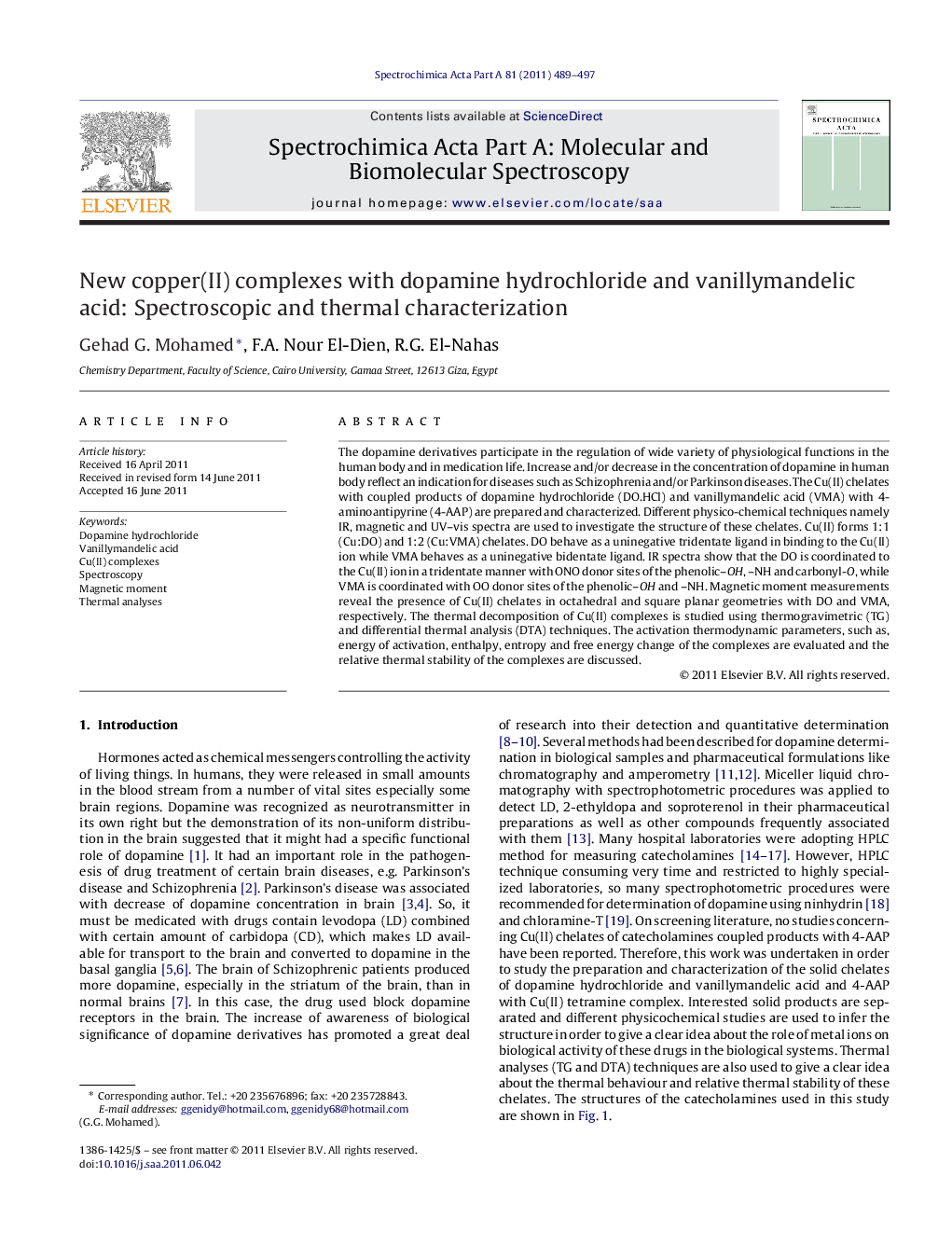| کد مقاله | کد نشریه | سال انتشار | مقاله انگلیسی | نسخه تمام متن |
|---|---|---|---|---|
| 1233584 | 968811 | 2011 | 9 صفحه PDF | دانلود رایگان |

The dopamine derivatives participate in the regulation of wide variety of physiological functions in the human body and in medication life. Increase and/or decrease in the concentration of dopamine in human body reflect an indication for diseases such as Schizophrenia and/or Parkinson diseases. The Cu(II) chelates with coupled products of dopamine hydrochloride (DO.HCl) and vanillymandelic acid (VMA) with 4-aminoantipyrine (4-AAP) are prepared and characterized. Different physico-chemical techniques namely IR, magnetic and UV–vis spectra are used to investigate the structure of these chelates. Cu(II) forms 1:1 (Cu:DO) and 1:2 (Cu:VMA) chelates. DO behave as a uninegative tridentate ligand in binding to the Cu(II) ion while VMA behaves as a uninegative bidentate ligand. IR spectra show that the DO is coordinated to the Cu(II) ion in a tridentate manner with ONO donor sites of the phenolic–OH, –NH and carbonyl-O, while VMA is coordinated with OO donor sites of the phenolic–OH and –NH. Magnetic moment measurements reveal the presence of Cu(II) chelates in octahedral and square planar geometries with DO and VMA, respectively. The thermal decomposition of Cu(II) complexes is studied using thermogravimetric (TG) and differential thermal analysis (DTA) techniques. The activation thermodynamic parameters, such as, energy of activation, enthalpy, entropy and free energy change of the complexes are evaluated and the relative thermal stability of the complexes are discussed.
The dopamine derivatives participate in the regulation of wide variety of physiological functions in the human body and in medication life. The Cu(II) chelates with coupled products of dopamine hydrochloride (DO.HCl) and vanillymandelic acid (VMA) with 4-aminoantipyrine (4-AAP) are prepared and characterized using IR, magnetic and UV–vis spectra that are used to investigate the structure of these chelates. Cu(II) forms 1:1 (Cu:DO) and 1:2 (Cu:VMA) chelates. The structures of the complexes are given.Figure optionsDownload as PowerPoint slideProposed structures of complexes (A) DO.HCl and (B) VMA with copper tetramine and 4-AAP.Highlights
► The dopamine derivatives participate in the regulation of wide variety of physiological functions in the human body and in medication life. Increase and/or decrease in the concentration of dopamine in human body reflect an indication for Schizophrenia and/or Parkinson diseases.
► The dissociation constants of catecholamines and vanillymandelic acid were determined spectrophotometrically.
► The Cu(II) chelates with coupled products of dopamine hydrochloride and vanillymandelic acid with 4-aminoantipyrine are prepared and characterized using different physico-chemical techniques.
► The UV–vis properties of the free catecholamines and vanillymandelic acid were investigated.
► The mass spectra of the complexes were studied and schemes representing the possible fragmentation pathways are given.
Journal: Spectrochimica Acta Part A: Molecular and Biomolecular Spectroscopy - Volume 81, Issue 1, 15 October 2011, Pages 489–497